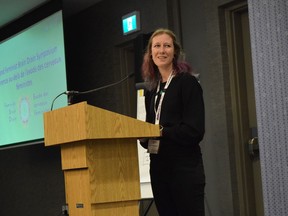“There’s a crisis. And if we don’t find stable funding for these organizations, it’s going to put in jeopardy their ability to do this work.”

Article content
ST. JOHN’S, N.L. — A new report says staff at women’s shelters and transition homes across the country are feeling burned out, underpaid and overburdened with administrative work.
The review from national non-profit Women’s Shelters Canada surveys more than 300 shelter and transition house employees across Canada and finds about 30 per cent of respondents felt overwhelmed by their workload and were thinking about leaving their jobs.
Advertisement 2
Article content
Article content
The report says 66 per cent of respondents said they earn less than $50,000 a year, and nearly a third said they worked a second job to make ends meet.
Robyn Hoogendam, the group’s research and policy manager, says the review found staff still struggling with massive challenges that emerged during the COVID-19 pandemic, including more severe violence and an increase in addictions and mental health issues.
She says shelter staff are taking on more work with more complex cases, but funding hasn’t increased to allow a boost to their salaries.
Hoogendam says shelter directors and staff must juggle daily shelter work with fundraising and grant applications, which require lengthy written submissions to various levels of government several times a year, as well as regular reports about how money is spent.
She says the administrative work is consuming resources, and the government money isn’t enough to keep up with inflation, shelter demand or salary needs.
“There’s a crisis. And if we don’t find stable funding for these organizations, it’s going to put in jeopardy their ability to do this work,” Hoogendam said in an interview. “And this is life-saving work that these organizations do, every day.”
Advertisement 3
Article content
Jodi McDavid is among those shelter workers with two jobs. She runs the Cape Breton Transition House Association in Nova Scotia, which includes a shelter, a small apartment complex and a rooming house.
She says if she didn’t also teach part-time at the local university, she wouldn’t be able to get by.
Her front-line staff make an average of $54,000 a year — about $30,000 less than what someone working for victims’ services with the provincial court system makes. She says it’s nowhere near enough.
“Everyone says, ‘OK, do self care,’ and a lot of responsibility is put on the individual, which I agree with,” McDavid said in an interview. “But at the same point, if we are not making adequate wages, how do you do that wellness? How do you have the money to go and do that? You can’t just go on a vacation.”
In its budget last week, the Nova Scotia government boosted core funding for women’s shelters and transition homes by $7.1 million. It’s the first significant increase in a decade, said Ann de Ste Croix, the provincial co-ordinator of Nova Scotia’s Transition House Association.
Advertisement 4
Article content
But both de Ste Croix and McDavid said more permanent, reliable funding is still needed to address the low wages, staff burnout and escalating needs in the province’s shelter systems.
The money comes nearly a year after publication of the final report from a public inquiry into the April 2020 Nova Scotia mass shooting that began when the killer attacked his common-law spouse. He killed 22 people, including a pregnant woman, over the course of 13 hours before he was shot by police.
The inquiry’s report said intimate partner violence should be declared a public health emergency, and it called for stable funding for organizations working to prevent it.
This report by The Canadian Press was first published March 7, 2024.
Article content



